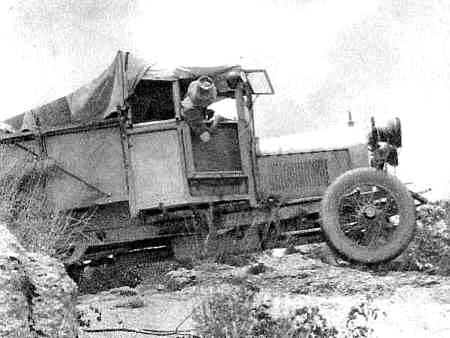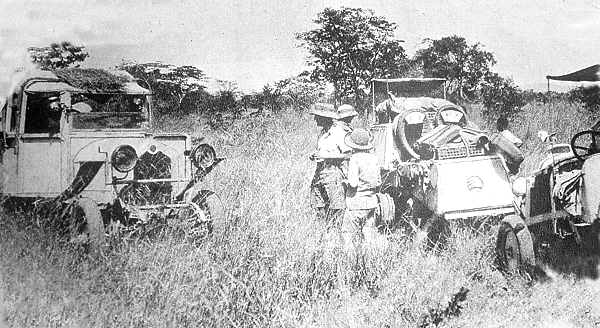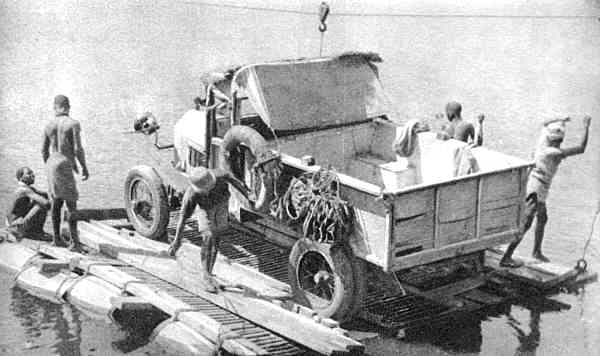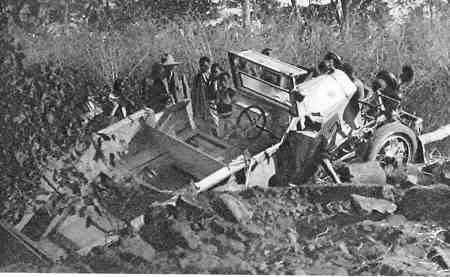The Court Treatt Expedition 1924-1926
The Expedition Part 2 - Victoria Falls to Sudan
Northern Rhodesia (Zambia)

Over the rocky road
The Zambezi gorge below Victoria Falls was crossed by getting special
permission to drive over the only bridge then existing which carried the
railway and camp was set up close to the Falls. Because of
the heavy rains the Falls were particularly spectacular that year. Errol
Hinds, with his now mended arm, and in new clean clothes, was waiting to
join them and the opportunity was taken for a good rest, an overhaul of
the vehicles, a general re-stocking and some sight seeing. Stella
admired some small grey monkeys and was overjoyed when she was given two
which she called Kima and Bibi; a cage was made for them and they would
now accompany the expedition. Eventually, with everything ready, they
set off again on Wednesday, May 21st 1925.
Although the rain had stopped, going was slow at first as the road was
deep sand and on the first day only 17.9 miles (29 kilometres) was
covered. The railway line was largely followed taking advantage of the
cleared strip down the side through the bush but sometimes they had to
drive right on the side of the railway itself causing on one occasion a
near miss with a passing train. Passing through Kafue, now a National
Park, they found preparations being made for a visit by the Prince of
Wales on his Southern Africa Royal tour, which also used a fleet of
Crossley cars. Also in Kafue, they met part of the Citroen
"Croisiere Noire" expedition which under Charles Brull had left the main
party in Tabora, Tanzania and were heading for Cape Town which they
reached on August 1st, 1925. The meeting is not mentioned in the book
apart from a rather cryptic " We heard at the Kafue that the road to
Broken Hill, a distance of about 220 miles, was better than the road we
had come over". The Court Treatt party continued through Lusaka, which
although now the capital of Zambia gets only a passing mention, and on
to Broken Hill (now Kabwe) where they stopped for two days.

The meeting with the Citroen expedition
North of Broken Hill the road got worse and was quite rocky and 20
miles (32 kilometers) from Chiwefre on June 15th they broke a spring and
had no spare. The nearest railway station was now nearly 150 miles away
at Kishutu (location unclear) so the other car was driven there and an
urgent telegram sent to Nyamandhlovu in Southern Rhodesia where there
was a spare in the supply dump. A box containing the spare was on the
next goods train and three days later it was at the camp waiting to
be fitted and on June 19th they were off again covering 130 miles (210
kilometres) before being stopped again by failed bearings in the back
axle which delayed them for a further day. Mpika was reached on June
21st at mid-day and they lunched with the District Commissioner and that
night took special care in the camp as the area was troubled by man
eating lions, thirteen people had been killed in the last eight days.
A brief mention is made in the book that on June 23rd they camped
"near Gower Brown's place". This has to be a mistake for Sir Stewart
Gore-Browne who had built a large estate and English style house at
Shiwa Ngandu which still exists and was described by Christina Lamb in
her 1999 book "Africa House". He was usually welcoming of passing
travellers so why they did not make contact is a mystery.

Crossing the Chambesi river
The road was in the process of being improved and several bridges had
been built but the Chambesi (Chambeshi) river, known for its many
crocodiles, had to be crossed by raft drawn across by rope. The cars
were unloaded to reduce weight and, after adding oil drums for extra
buoyancy, the pontoon raft would just carry the weight of one empty
vehicle. The equipment and people crossed by canoe.
Kasama was reached on June 26th and from here there was a good road to
Abercorn (Mbala) on the southern tip of Lake Tanganyika where they
rested for three days.
Tanganyika (Tanzania)
The apparently obvious route north from Abercorn is to go up the east
side of Lake Tanganyika but even today this is not an easy route so with
the roads as they then were it would probably have been impassable.
Instead they headed almost due east along the Tanganyika/Rhodesia border
towards the top end of Nyasaland (Malawi) and there link up with the
main East African road system.
Leaving Abercorn on Wednesday 1st July the road was good for the first
few miles but then they reached the first doubtful bridge. The bridges
on the route, and there were lots of them, were made of tree trunks
covered with earth and some were rather old and weak. They estimated
that of the around one hundred and eighty that had to be crossed, around
half needed to be rebuilt. On around 13th of the month a rest camp was
made and the party set off on hunting expeditions for a few days.

The runaway car
Setting off on 24th July they started to encounter some severe
gradients and on one of these the second car failed to get up and ran
backwards fortunately hitting a tree before too much speed was built up.
With the help of a block and tackle it was extracted from the tree and
brought to the top where the damage was assessed. The rear axle was
broken, the torque tube bent and the radiator punctured but with
the spares they had and a bit of blacksmith work the car was patched up
by the end of the next day.
Tukuyu, where the Government station surrounded by lawns and roses was
most admired, was reached on August 4th. Although off the route a trip
of about four hours was made heading south to see Lake Nyasa (Malawi)
both for sightseeing and to visit one of the supply dumps at Mwaya Beach
but on reaching it, found only food and no spare parts which had either
not been put on the lake steamer or not taken off when it called further
north at the landing stage at Karonga. (note- the diversion to Mwaya
Beach seems a long way off route unless names of places have changed
drastically. The modern Mwaya Beach is about halfway down the lake near
Mzuzu, a long way to go unless there was a special undisclosed reason
such as visiting friends. Or, did they intend originally to cut across
Northern Rhodesia (Zambia) further south and hit the lake further down
and drive north up the lakeside road.)
After two days relaxing they turned round and headed back to Tukuyu
and back over the very steep Igali Pass and on to the main road. A one
month halt would be had in southern Tanganyika to allow Thomas Glover to
film animals in the game parks and a site near the village of Maereres
(modern location unknown) was selected.
Leaving their camp they headed along good roads through Iringa to
Dodoma making good progress until up near the Kenya border they broke an
axle and had no spare. Court Treatt (C.T.) and Errol headed off in the
working car to Kondoa where there was a telegraph station and wired
Nairobi for the spares but they could not be found and C.T. had to make
the journey himself only to find the spares had never left Mombasa. The
parts were put on the train to Nairobi and C.T. drove day and night to
get them to the camp arriving on the 27th September.
They set off the next day continuing with good roads through Arusha
where they were troubled by thick dust but the bridges were at least now
in good condition.
Kenya and Uganda
Crossing into Kenya with Mount Meru and Kilimanjaro to their right,
the road crossed the Athi plains, teeming with game, and into Nairobi
with street lights, something they had not seen for many months. A short
break was taken to service the cars, have some new clothes made and
attend many social engagements including meeting the Governor Sir Edward
Grigg and his wife Lady Grigg before it was off again on the 10th
October driving still on good roads. Crossing into the Great Rift Valley
they travelled through farming country passing Lakes Naivasha and Nakuru
staying in rest huts and reached the equator. They passed through Uganda
with no problems and reached the Sudan border